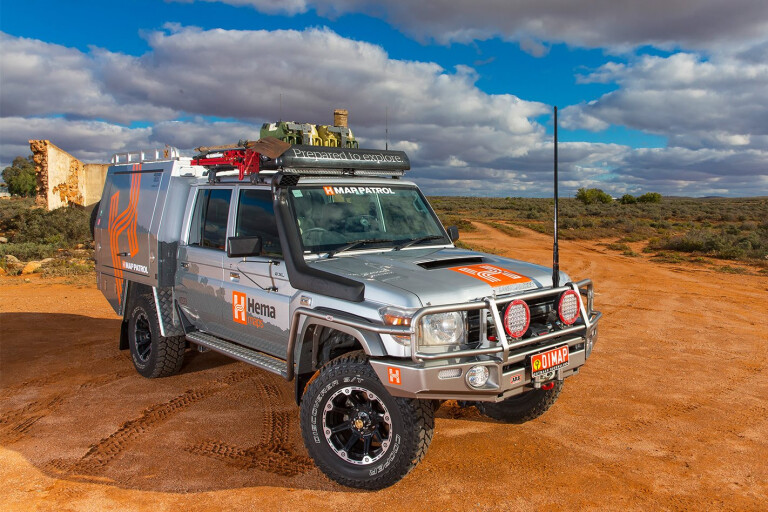
If you’ve ever toured Australia in your 4x4, chances are you’ve pored over a Hema map, either when preparing for an adventure or when navigating your way from one place to another.
Hema Maps products cover the entire country in great detail and in various formats, from touring atlases and detailed paper maps to electronic maps that can be viewed on PCs, tablets, phones and other GPS-enabled devices.
In addition to mapping information, Hema Maps products also incorporate a vast amount of other relevant data aimed squarely at four-wheel drive tourers, such as the history of specific areas, the flora and fauna you’re likely to encounter, services and accommodation options, important contact details and travel advice, and much, much more.
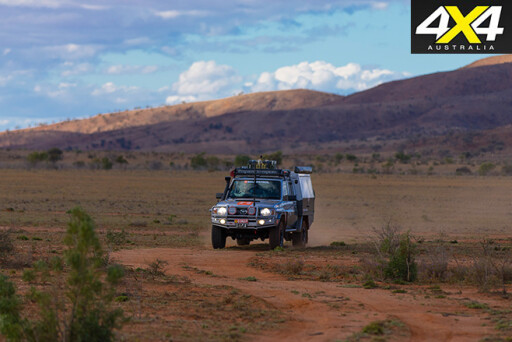 To gather all of this information, and to make sure it’s up to date, Hema sends field teams deep into the Australian bush to literally drive every road and track in the country. As any four-wheel driver knows, heading bush for weeks at a time in potentially unfamiliar territory requires a well-prepared, well-equipped and seriously off-road capable vehicle, and this Toyota Land Cruiser 70 Series double cab is the latest in a long line of vehicles (that Hema dubs Map Patrols) tasked with that duty.
To gather all of this information, and to make sure it’s up to date, Hema sends field teams deep into the Australian bush to literally drive every road and track in the country. As any four-wheel driver knows, heading bush for weeks at a time in potentially unfamiliar territory requires a well-prepared, well-equipped and seriously off-road capable vehicle, and this Toyota Land Cruiser 70 Series double cab is the latest in a long line of vehicles (that Hema dubs Map Patrols) tasked with that duty.
As well as being packed with hi-tech mapping and data-collection equipment, this Cruiser has the off-road arsenal to tackle some seriously tough terrain without fear of becoming stranded. After all, the Hema team has plenty of experience when it comes to properly setting up a vehicle for the task at hand.
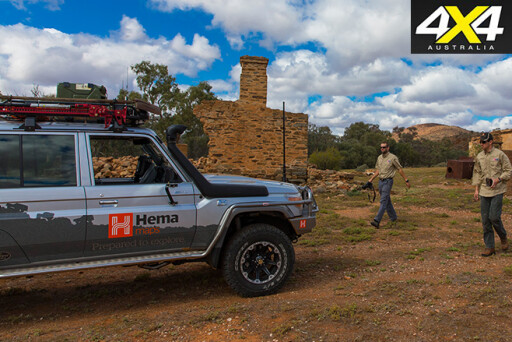 “Our goal has always been to map every publicly accessible road or track and put that on a map,” Rob Boegheim, Hema’s Managing Director, explains. “We ask our mapping teams to push the boundaries on where they go. We want them to go down roads that we’ve never been down before, go and find out where tracks take us, and sometimes that means getting into difficult technical situations or getting stuck, and you need the ability to get out. And predominantly you travel solo, so it needs to be fully self-sufficient, with a lot food and water, as well as carrying the gear needed.”
“Our goal has always been to map every publicly accessible road or track and put that on a map,” Rob Boegheim, Hema’s Managing Director, explains. “We ask our mapping teams to push the boundaries on where they go. We want them to go down roads that we’ve never been down before, go and find out where tracks take us, and sometimes that means getting into difficult technical situations or getting stuck, and you need the ability to get out. And predominantly you travel solo, so it needs to be fully self-sufficient, with a lot food and water, as well as carrying the gear needed.”
The Hema team was able to draw on its years of experience when it came to setting up this vehicle. “We’ve been setting up Map Patrols since the first one in 1996, when we first started getting out with a GPS and a laptop and doing what we do,” Rob says. “We sat down with this one and asked: What do we need this vehicle to do, where do we need it to go, what kind of equipment do we need to carry, what kind of fuel, people, gear and mapping gear? The whole build, it’s been nine months to get to this point.”
As a base platform, the 70 Series Land Cruiser ticked many boxes – powerful TDV8, strong live-axle driveline, good payload, dual-cab body, bush-proven design and Australia-wide parts and service back-up – but it also had a few shortcomings, such as the narrow rear-wheel track and long rear overhang.
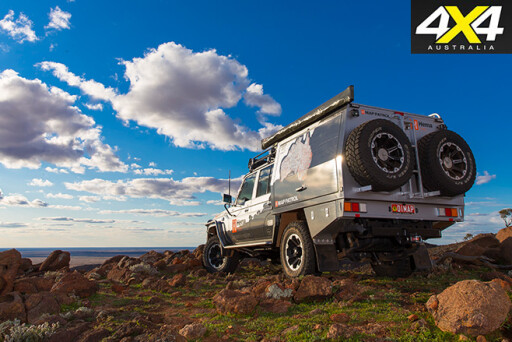 These issues were both addressed at the start of this Map Patrol project, with an ARB Old Man Emu GVM upgrade fitted prior to the vehicle being registered, widening of the rear track by 105mm (to match the front track) and extension of the chassis by 200mm to lengthen the wheelbase for better load carrying ability and weight distribution.
These issues were both addressed at the start of this Map Patrol project, with an ARB Old Man Emu GVM upgrade fitted prior to the vehicle being registered, widening of the rear track by 105mm (to match the front track) and extension of the chassis by 200mm to lengthen the wheelbase for better load carrying ability and weight distribution.
The chassis extension and strengthening was performed by Queensland-based company Creative Conversions, while ARB Toowoomba installed a Multidrive Tru Tracker rear-track-width correction system. The Tru Tracker is a complete rear axle width-correction system that utilises the Cruiser’s existing diff housing; extension hubs are installed on either side of the housing and the kit includes extended axles, brake lines and parking brake attachment plates.
“Those two things [the chassis extension and Tru Tracker] have really helped with the core stability of the vehicle, its load-carrying capacity, along with the GVM upgrade that we got pre-delivery,” Rob says.
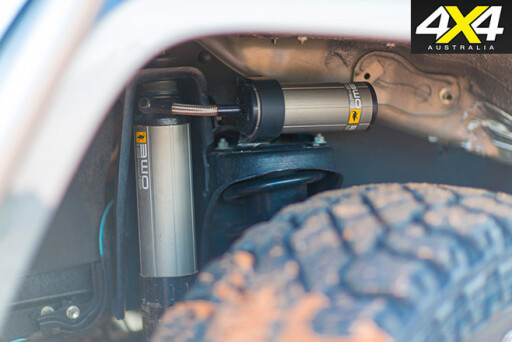 With the Map Patrol carrying a lot of sensitive gear over very rough terrain for up to 10-12 hours a day, the right suspension choice was of critical importance, and the fitment of OME springs and BP-51 shock absorbers keep gear and occupants safe and comfortable. “The BP-51s from ARB; fantastic suspension,” Rob says. “It’s the best suspension I’ve driven on in all my 25 years of mapping out there.”
With the Map Patrol carrying a lot of sensitive gear over very rough terrain for up to 10-12 hours a day, the right suspension choice was of critical importance, and the fitment of OME springs and BP-51 shock absorbers keep gear and occupants safe and comfortable. “The BP-51s from ARB; fantastic suspension,” Rob says. “It’s the best suspension I’ve driven on in all my 25 years of mapping out there.”
A key to the outstanding performance delivered by OME BP-51 shocks is their bypass technology (as used in racing shock absorbers), which delivers a smooth ride by eliminating harshness at each end of the shock stroke, whether on compression or rebound. The BP-51 shocks can also be adjusted (both compression or rebound) to suit different driving and track conditions.
Protecting the Cruiser, its occupants and its valuable and sensitive electrical equipment was deemed of critical importance in this vehicle build. Up front the Cruiser sports an ARB bull bar, side rails and side steps, as well as an ARB underbody protection system. The bar houses a Warn Zeon 12,000lb winch and is the mounting point for a pair of ARB Intensity LED driving lights.
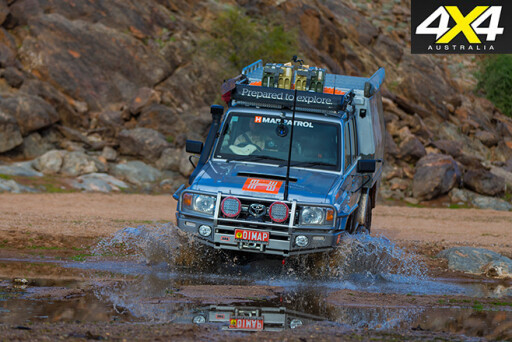 “When the Map Patrol team is out there, it’s their safety and productivity that’s paramount when dealing with difficult terrain, and that’s where ARB comes in,” Rob says. “So that’s why, for the last 20 years, we’ve chosen ARB to properly equip our vehicles and protect our people and bring them home safely.”
“When the Map Patrol team is out there, it’s their safety and productivity that’s paramount when dealing with difficult terrain, and that’s where ARB comes in,” Rob says. “So that’s why, for the last 20 years, we’ve chosen ARB to properly equip our vehicles and protect our people and bring them home safely.”
The Metalink canopy on the rear of the Cruiser is split into two main areas: the driver’s side houses all the business stuff, while the passenger side provides access to water and kitchen facilities. The canopy also houses a vast array of electrical equipment, expertly installed by GlobalSat in Ipswich, Queensland.
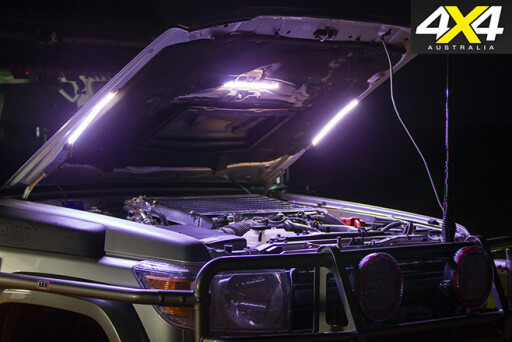 While there’s a dual-battery set-up under the bonnet of the Cruiser, the canopy is home to its own Redarc battery management system with two 150A lithium batteries. Power management components include a 1000W pure sine wave inverter, 240V outlets, master switch and circuit breakers, various lighting systems, numerous 12V power outlets, solar input, Canon battery chargers, handheld UHF chargers, RDX data storage and more.
While there’s a dual-battery set-up under the bonnet of the Cruiser, the canopy is home to its own Redarc battery management system with two 150A lithium batteries. Power management components include a 1000W pure sine wave inverter, 240V outlets, master switch and circuit breakers, various lighting systems, numerous 12V power outlets, solar input, Canon battery chargers, handheld UHF chargers, RDX data storage and more.
On the driver’s side of the canopy there’s space to house luggage above two drawers, one containing camera gear and the other housing tools, tyre repair kit and spare parts. There’s a toolbox behind the rear wheel that holds ARB recovery gear such as straps and shackles.
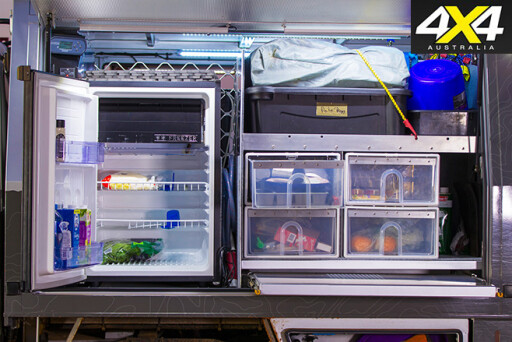 On the passenger side of the canopy is the kitchen, which incorporates a 75L water tank, an 85L upright Engel fridge, dual-fuel stove, washing tub, extendable table and drawers. The toolbox on this side of the vehicle houses an ARB air compressor and associated equipment, as well as some additional recovery gear.
On the passenger side of the canopy is the kitchen, which incorporates a 75L water tank, an 85L upright Engel fridge, dual-fuel stove, washing tub, extendable table and drawers. The toolbox on this side of the vehicle houses an ARB air compressor and associated equipment, as well as some additional recovery gear.
Hanging off the rear of the canopy are two spare wheels, between which there’s a ladder to access the rack up top. The Cruiser runs Cooper ST Maxx tyres. “We’ve been running Cooper tyres ever since I started mapping in 1996,” Rob says, “and these new ST Maxx tyres are just phenomenal; I’m starting to forget the last time I changed a tyre, just because these things are so reliable.”
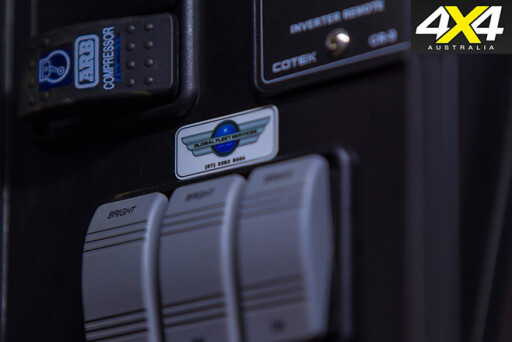 In the cabin, there are so many switches, gauges and fuse panels that it almost resembles a flight deck. There are switches for various lights, fuel tanks, batteries, trailer brakes, audio streaming, inverters and more, while gauges cover the usual things as well as boost, EGT, voltage of main and auxiliary systems, and Amps. Warning lights and alarms alert occupants to any potential issues with low coolant, or any canopy doors left ajar.
In the cabin, there are so many switches, gauges and fuse panels that it almost resembles a flight deck. There are switches for various lights, fuel tanks, batteries, trailer brakes, audio streaming, inverters and more, while gauges cover the usual things as well as boost, EGT, voltage of main and auxiliary systems, and Amps. Warning lights and alarms alert occupants to any potential issues with low coolant, or any canopy doors left ajar.
The cabin power system, also installed by GlobalSat, is an electrical work of art. It’s located behind the rear seat and incorporates a Redarc 300W pure sine wave inverter, RDX power supply, four 240V outlets, and super-neat fuse blocks and circuit breakers. There are a number of USB and 12V outlets scattered about the cabin.
On the safety front, there’s a PLB (Personal Locator Beacon) in case there’s an issue with the sat-phones, a SPOT tracker for daily check-ins with the office, a fire extinguisher by the passenger seat and another in the canopy at the rear.
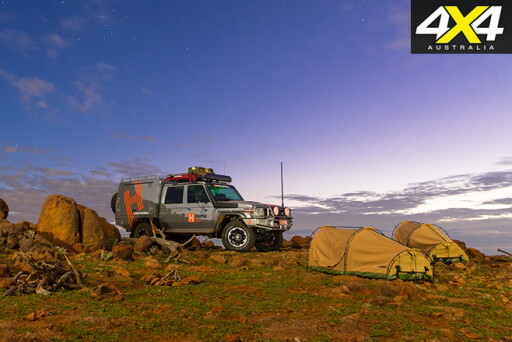 As the Hema teams sometimes travel with family, two child-seat anchor points have been fitted and the canopy rack is often used for carrying additional swags that won’t fit inside. There’s also a Patriot camper trailer that can often be seen following this Map Patrol around the country.
As the Hema teams sometimes travel with family, two child-seat anchor points have been fitted and the canopy rack is often used for carrying additional swags that won’t fit inside. There’s also a Patriot camper trailer that can often be seen following this Map Patrol around the country.
“We’re a pretty close-knit team at Hema and whenever any of our guys go out on map patrol we want to make sure that they’ve got the right equipment, they’re supported, they’ve got the right comms gear, tracking gear… we’ve got 24/7 satellite tracking on the vehicle and we’re ready to swing into action at any point to support them out there.”
Even with a rig that’s this off-road capable and self-sufficient, there’s always an element of uncertainty when travelling in remote areas, so it’s nice to know there’s back-up if needed. One thing’s for certain, though: the operators of this Map Patrol will never get lost.
COLLECTING DATA
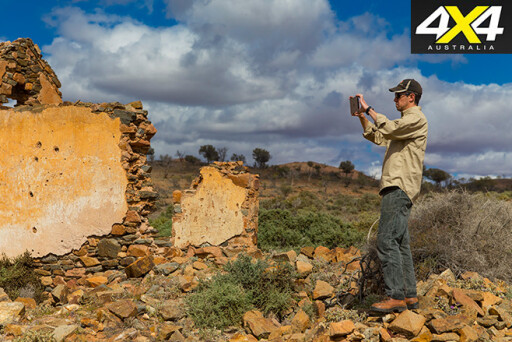 Collecting data in remote areas is the Map Patrol’s raison d’être. “Most other mapping companies, particularly street mapping companies, would say ‘it’s all outback, it’s dirt road, take all that off the map because it’s not relevant’.
Collecting data in remote areas is the Map Patrol’s raison d’être. “Most other mapping companies, particularly street mapping companies, would say ‘it’s all outback, it’s dirt road, take all that off the map because it’s not relevant’.
But for us, that’s exactly the kind of information we need to highlight and bring to the front,” Rob Boegheim explains. “Our goal has always been to map every public accessible road or track and put that on a map, and take out all the other noise that just creates confusion.”
To achieve this, the Map Patrol is packed with complex gear. Sitting behind a fibreglass shroud on the ARB roof rack is the all-important GPS antenna. Signals from the antenna are processed by a Differential GPS (DGPS), which is mounted in a roof console. The DGPS provides half-metre accuracy, ensuring that Hema’s products are as precise as possible.
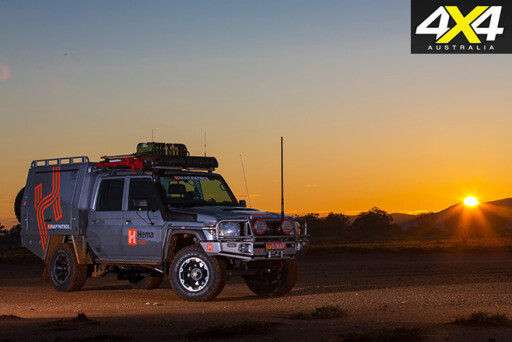 “You don’t need that accuracy for a printed product where the width of a millimetre on a map could be hundreds of metres or half a kilometre on the ground,” Rob says. “But as soon as you’re getting into a full-blown navigation system where you’re doing voice guidance, then everything’s got to be in the right spot.”
“You don’t need that accuracy for a printed product where the width of a millimetre on a map could be hundreds of metres or half a kilometre on the ground,” Rob says. “But as soon as you’re getting into a full-blown navigation system where you’re doing voice guidance, then everything’s got to be in the right spot.”
Location information from the GPS is then fed into a laptop computer mounted in front of the passenger, who then tags information to each plot or point. If that point is an accommodation location, for example, information could include the address, type of accommodation, permits required and facilities available, as well as photos of the location.
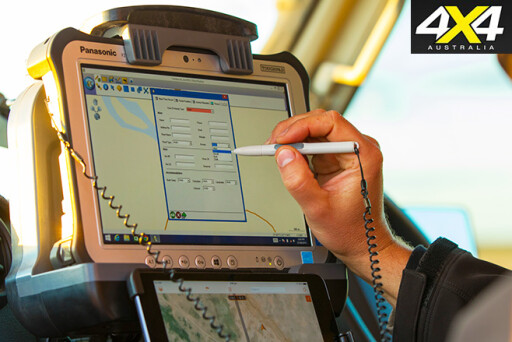 Below the laptop sits an iPad that’s preloaded with information that explorers can access prior to the heading into the field. It can be used for referencing, while a second rear-mounted iPad is used for purposes such as uploading information on conditions for other travellers to see.
Below the laptop sits an iPad that’s preloaded with information that explorers can access prior to the heading into the field. It can be used for referencing, while a second rear-mounted iPad is used for purposes such as uploading information on conditions for other travellers to see.
The centre console houses a sat-phone handset and a detachable sat-phone dock, as well as a 3G mobile phone cradle and iPhone. The glovebox houses an RDX storage device and a multi-format SD card reader. On the driver’s side of the roof console is a UHF transceiver.

COMMENTS